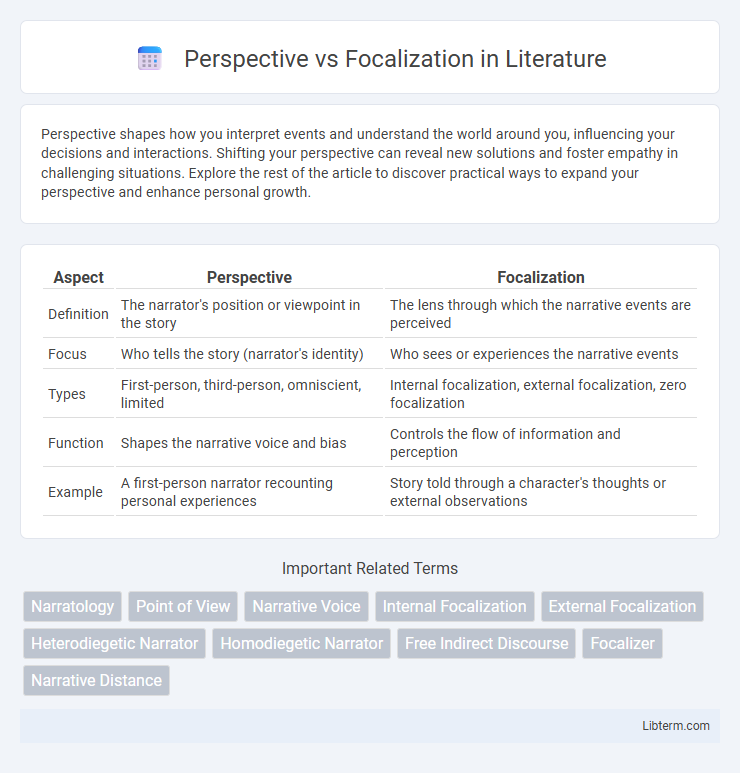Perspective shapes how you interpret events and understand the world around you, influencing your decisions and interactions. Shifting your perspective can reveal new solutions and foster empathy in challenging situations. Explore the rest of the article to discover practical ways to expand your perspective and enhance personal growth.
Table of Comparison
| Aspect | Perspective | Focalization |
|---|---|---|
| Definition | The narrator's position or viewpoint in the story | The lens through which the narrative events are perceived |
| Focus | Who tells the story (narrator's identity) | Who sees or experiences the narrative events |
| Types | First-person, third-person, omniscient, limited | Internal focalization, external focalization, zero focalization |
| Function | Shapes the narrative voice and bias | Controls the flow of information and perception |
| Example | A first-person narrator recounting personal experiences | Story told through a character's thoughts or external observations |
Understanding Perspective in Narrative
Understanding perspective in narrative centers on the viewpoint from which a story is told, shaping how information and events are presented to the reader. Focalization defines the lens through which the narrative's perception is filtered, distinguishing between internal focalization (access to a character's thoughts and feelings) and external focalization (limited to observable actions). Differentiating perspective and focalization clarifies how authors control narrative distance and guide audience interpretation.
Defining Focalization: A Narrative Lens
Focalization in narrative theory refers to the perspective through which a story's events and experiences are perceived and filtered, shaping how information and emotions are conveyed to the audience. Unlike perspective, which emphasizes the narrator's point of view, focalization centers on who or what controls the narrative vision, be it a character, an omniscient narrator, or an external observer. Gerard Genette's concept defines focalization as the lens determining the scope and depth of knowledge within a narrative, affecting reader engagement and interpretation.
Key Differences Between Perspective and Focalization
Perspective refers to the viewpoint from which a story is narrated, often shaped by the narrator's position and opinions, while focalization concerns the lens through which information is filtered, highlighting whose consciousness or perception guides the narrative. Perspective encompasses the broader narrative stance, including first-person or third-person narration, whereas focalization zeroes in on the specific character or entity's internal experiences and knowledge. Key differences lie in perspective addressing the narrative voice's angle, and focalization focusing on whose internal viewpoint or experience shapes the story's presentation.
Types of Perspective in Storytelling
Types of perspective in storytelling include first-person, where the narrator is a character within the story, providing intimate insights and subjective experiences; third-person limited, offering a focused viewpoint on one character's thoughts and feelings while maintaining narrative distance; and third-person omniscient, granting an all-knowing narrator access to multiple characters' internal states and broader story context. Each perspective shapes the reader's engagement by influencing the depth of character insight and narrative reliability. Understanding focalization, which controls the lens through which the narrative is presented, further refines how events and emotions are perceived within these perspectives.
Varieties of Focalization: Internal, External, and Zero
Varieties of focalization reveal how narrative perspective shapes a story's perception: internal focalization delves into a character's thoughts and feelings, providing intimate access to their inner world; external focalization limits the viewpoint to observable actions and dialogues, staying outside characters' minds; zero focalization offers an omniscient stance with unrestricted knowledge, revealing events beyond any single character's awareness. Understanding these distinctions enriches textual analysis by clarifying how information is filtered and presented to the reader. The choice between internal, external, and zero focalization directly influences narrative depth, reliability, and emotional engagement.
How Perspective Influences Reader Engagement
Perspective shapes reader engagement by determining the angle through which the story unfolds, guiding emotional and cognitive connections with characters. First-person perspectives create intimacy, allowing readers direct access to thoughts and feelings, intensifying empathy and involvement. Third-person limited focalization balances insight and distance, enabling readers to engage deeply while maintaining narrative complexity and suspense.
The Role of Focalization in Shaping Meaning
Focalization directs the narrative perspective by controlling what information is perceived and how it is interpreted, significantly shaping the reader's understanding of a text. This narrative technique filters events through a specific character's consciousness, influencing emotional engagement and thematic emphasis. By limiting or expanding access to certain thoughts and experiences, focalization defines the depth and scope of meaning constructed within a story.
Narrative Voice: Linking Perspective and Focalization
Narrative voice intricately links perspective and focalization by controlling how a story's events and characters are perceived through a specific lens. Perspective denotes the narrator's position or attitude, shaping the overall interpretation of the plot, while focalization specifies the viewpoint from which information is filtered, determining the scope of knowledge available to the audience. This interplay defines narrative reliability and deepens character insight, making perspective and focalization essential for nuanced storytelling.
Common Mistakes in Using Perspective vs Focalization
Confusing perspective with focalization often leads to unclear narrative viewpoints, as perspective refers to the broader narrative stance while focalization centers on the specific lens through which events are perceived. A common mistake is attributing a character's thoughts directly to the narrator, blending internal focalization with an external narrative perspective improperly. Writers should distinctly separate who has the knowledge (perspective) from who perceives the events (focalization) to maintain narrative clarity and coherence.
Practical Tips for Writers: Choosing the Right Technique
Writers should distinguish between perspective, which defines the narrator's overall viewpoint, and focalization, which controls the lens through which a story's events are perceived. For clear narrative direction, choose first-person perspective to create intimacy and rely on internal focalization to reveal character emotions deeply. To maintain suspense or offer multiple viewpoints, third-person perspective with external or variable focalization provides flexibility and control over information flow.
Perspective Infographic

 libterm.com
libterm.com